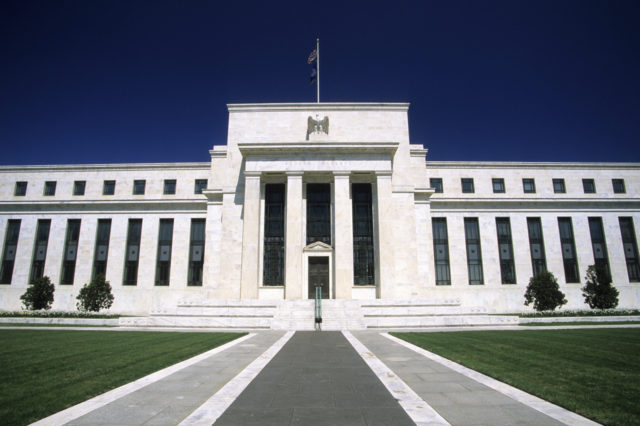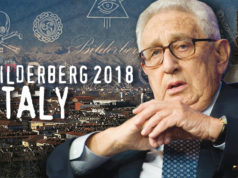The Truth About Central Banking and the Business Cycle.
We’ve all heard the story: An unregulated free market leads to wild booms and busts. If cowboy capitalists are left without careful oversight, the economy is doomed to fluctuate like a roller-coaster. That’s why it is the government’s job to tame the business cycle. Given that financial markets are where a lot of this unregulated mischief takes place, the central bank has a very special role.
This is the conventional wisdom these days. It’s the story taught unchallenged in schools, repeated in the news, and generally accepted as truth.
Libertarians know better. We argue that, in fact, central banks cause the business cycle; they don’t correct it. The United States has not seen even a mildly unregulated financial market in the last century, so if we wish to identify what causes our booms and busts, it cannot be laissez-faire capitalism.
The basic Austrian school explanation is compelling: The central bank artificially lowers interest rates by creating money ex nihilo, which causes malinvestment and an unsustainable boom. The market eventually corrects itself when resources, labor, and capital get reallocated back into their appropriate sectors. This reallocation process is painful—it includes bankruptcy and unemployment—but it is necessary, like the drug addict who has to go through withdrawal before he is healthy again.
I believe this narrative to be true, but it is abstract. And if we want to understand the concepts more concretely, we need to dig deeper into specific aspects of the theory.
For example, just how does money creation lead to booms? If banks merely lend out more paper bills, why does that result in disaster? And does the boom really have to be unsustainable? If so, why?
We can answer these questions by first understanding how banking works in a free market. As this article explains, banks coordinate the plans of savers and consumers.
To briefly summarize, when someone saves their money in a bank, it becomes available for an entrepreneur to borrow. But even though an individual might deposit cash at a bank, this coordination is not about paper changing hands. It’s about something deeper.
When individuals save, they are choosing not to consume goods or services. And, at any given time, there is only a certain amount of goods and services in the economy. The act of saving allows certain people to consume resources in other people’s place.
Banks play the role of a middleman, coordinating who gets access to the finite pool of savings. Accurate coordination is paramount to a healthy economy, and it is why central banks are the root cause of the business cycle.
The amount of savings provides a natural constraint on the number of projects entrepreneurs can undertake at any given time. If there were an infinite amount of goods and services at our disposal, anyone could undertake the grandest, most resource-intensive project imaginable without caring about the consequences. But we live in a world of scarce resources; some projects can go forward and others must wait, or else the savings would run out before all the projects could be finished.
For example, imagine that a group of bricklayers thinks they have 10 times the amount of bricks they actually have in inventory. What happens after all their projects start? They run out of bricks and probably go bankrupt in the process.
This is what happens when central banks “stimulate” the economy by creating new money. Banks are encouraged to make loans not backed by real savings. In contrast to the free-market system, in which individuals have to refrain from consuming goods in order to save them, these new loans are made without any party forgoing their consumption. The pool of savings gets depleted faster than it is replenished.
This increased economic activity usually gets mistaken for real growth, as the economy transitions into the “boom” phase of the business cycle. Unfortunately, the boom carries the seeds of an inevitable bust, for a number of reasons.
Many of the new projects entrepreneurs undertake don’t have enough real savings to finance them. This is especially true of longer-term projects that would not be profitable at higher interest rates. Those projects are only undertaken because the central bank is pumping out cheap money.
Tangible wealth also gets destroyed during these artificial booms. For example, the resources and labor poured into the U.S. housing market prior to 2008 could have been utilized in other sectors of the economy. Instead, wealth was diverted into housing projects that proved worthless—but the resources were now unavailable for anything else. Ludwig von Mises called this phenomenon “malinvestment,” or literally, bad investment.
When the housing bubble popped, a huge, painful correction had to take place; capital and labor do not seamlessly transition from one sector of the economy to another. You can’t turn an empty subdivision into, say, an iPhone factory overnight. Temporary unemployment and bankruptcy are the inevitable results of malinvestment.
The story of business cycles would be bad enough if it ended there. However, when central banks are involved, it rarely does. Central banks often view an economic bust as reason for further intervention. What’s their solution? Create more money and lower interest rates even further.
If this spiral of intervention is not halted, central banks run a much higher risk than causing recessions; they risk destroying a currency. As more and more money gets pumped into the system, the value of each monetary unit decreases. And, given the reluctance of central banks to quit meddling in the economy, so much money can be created that it causes hyperinflation—an extremely painful economic scenario when a currency rapidly loses its purchasing power.
This is not mere speculation—check out the long list of countries that have destroyed their currencies through hyperinflation in the last century.
In fact, the United States’ central bank is currently pursuing a policy of extreme credit expansion, known as “quantitative easing.” The first two rounds of quantitative easing have predictably failed, so the third has started, despite lip service of slowing down. If our economy is not allowed to correct itself and liquidate all the malinvestment currently pervading it, the dollar may soon be added to the list of currencies destroyed by hyperinflation.
When central banks destroy the relationship between savers and consumers, between the amount of currency and the amount of real savings in an economy, we should expect business cycles as a result. And history seems consistently to back up this theory. Economic disaster could be avoided if one principle was clearly understood: Governments and central banks cannot create wealth by printing money. Real savings do not come fresh off a printing press.







